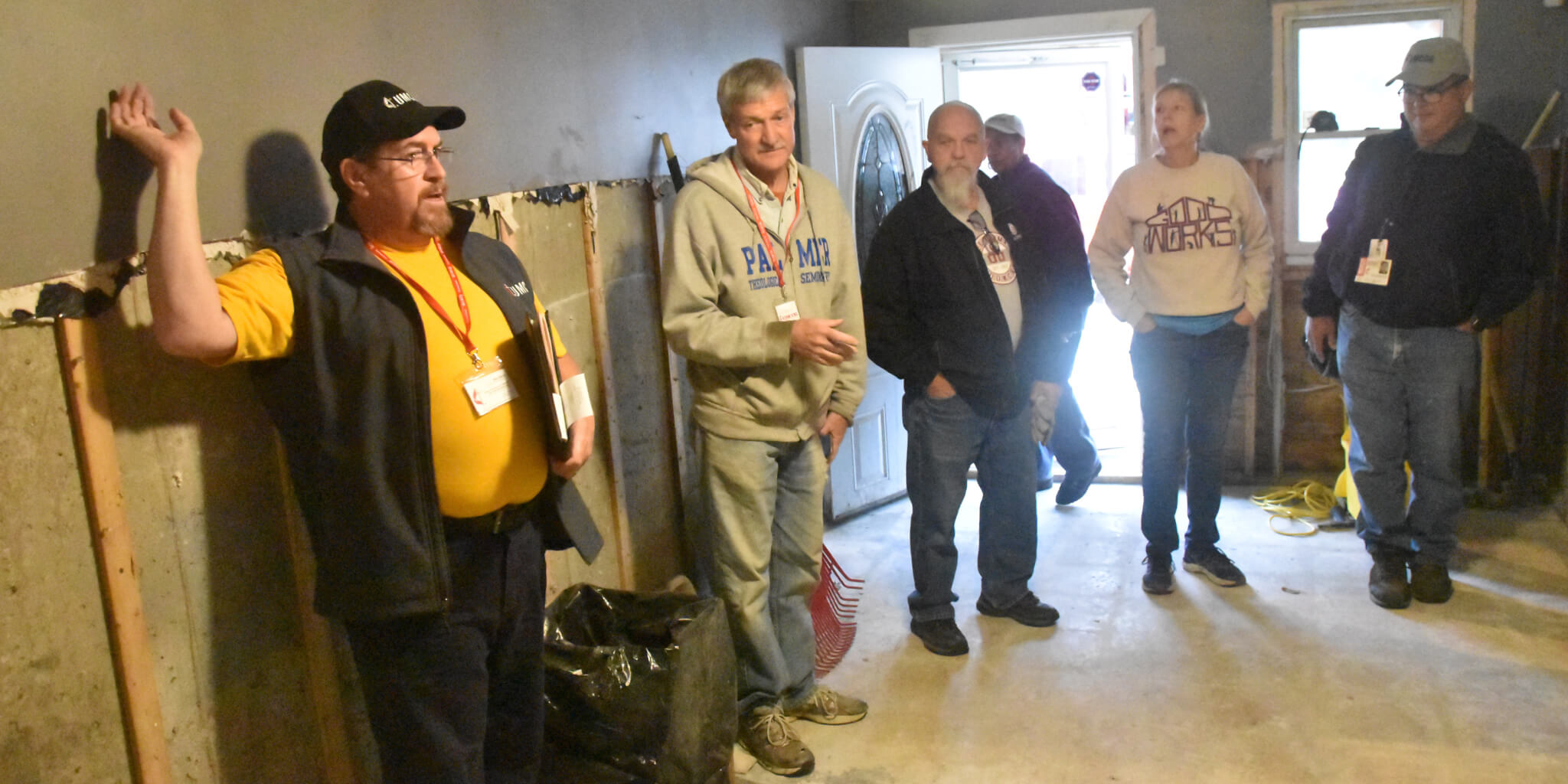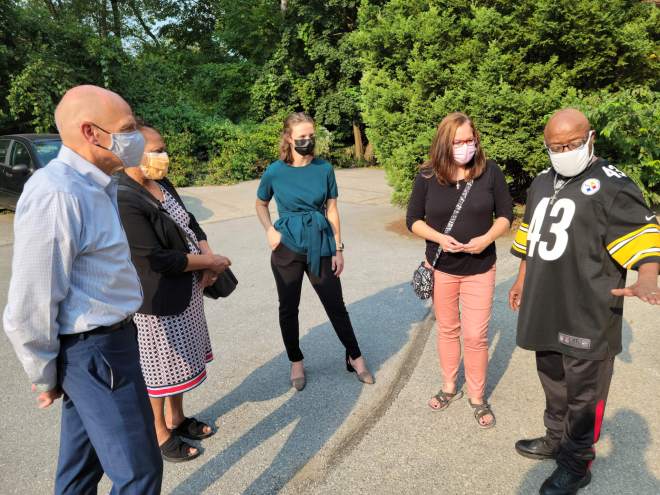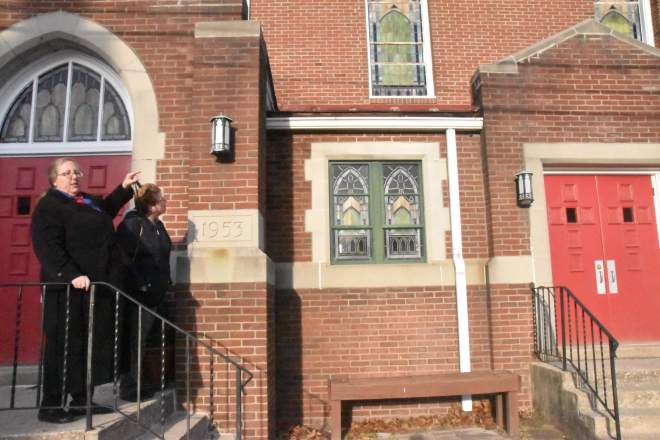
Bob Simcox (first from left) EPA’s Disaster Response Coordinator, discusses a plan of action for a home in Downingtown with an Early Response Team. The Rev. Allen Keller (second from left) started with Project Restoration on March 1 as case manager. PHOTO: JOHN W. COLEMAN
By Christie R. House
March 9, 2022 | HARRISBURG, PENNSYLVANIA
Hurricane Ida developed late in August 2021 as a devastating Category 4 storm, which made landfall in the Cayman Islands and Cuba and then gathered its full strength over the Gulf of Mexico. It’s fierce winds and rains rivaled Hurricane Katrina as it made landfall in Louisiana, Alabama and Mississippi. While Ida’s winds dissipated, the drenching rain continued as it carved a path North across the Eastern U.S. all the way up to Maine and into Canada, a storm full of surprises.
On September 1, Ida deposited 6-8 inches of rain and spawned seven tornadoes in Pennsylvania. By nightfall the rain had stopped, and residents in Downingtown figured they had seen the worst of it. But in the calm of the night, rivers and creeks started rising, some cresting beyond flood stage at peaks not seen in the last 100 years.
The Rev. Amy Banka, pastor of Hopewell United Methodist Church North of Downingtown, PA, describes the scene confronting residents along the Brandywine Creek on September 2.
“For a lot of home owners, the entire first level of their home was flooded. In some cases, that was the basement, but in others, the first floor. That sent residents onto second floors, not knowing how high the flood waters would rise. Some had to be evacuated by boats. Flooding of this kind is unique. Part of the reaction we were hearing from people was the grief and emotional trauma they experienced in that level of fear, trying to get out and hearing the cries for help from their neighbors.”
Hopewell UMC was well situated to respond immediately. The main church was out of the flood zone, though the Well, a community center they opened in Downingtown proper, suffered some damage. Some of their staff and congregation members were greatly affected. Though this part of Pennsylvania does not experience frequent severe storms, the Eastern Pennsylvania Conference holds United Methodist Committee on Relief (UMCOR) Early Response Team (ERT) and Volunteer in Mission trainings regularly.
“We’ve worked with UMCOR for many years in other communities,” Banka explained. “So, we knew how to do this on our own.”
She also commended the faith, nonprofit, business and municipal communities in Downingtown. They came together to respond to this disaster and collaborated well, offering the best of each organization. For Hopewell, that was providing volunteer teams for mud-out, clean-up and repair work.
Soon, UMCOR Early Response Teams from other areas arrived to assist the Hopewell teams. A lot was accomplished in Downingtown because of the preparedness and organization skills of those involved.
But other communities lack resources or experience to pull responders and volunteers together, so, six months later, families are still out of their homes, without means or ability to recover.
In addition to the damage caused by Hurricane Ida, Eastwick, a community near the Philadelphia airport, suffered major damage from Hurricane Isaias, which struck the area in August 2020. Without a FEMA declaration, some residents there are still waiting for home repairs and flood mitigation.
The Rev. Dawn Taylor-Storm, executive director for Connectional Ministries with the Eastern Pennsylvania Conference (EPA), worked with the conference’s Disaster Response Coordinator, Robert Simcox, and Bishop John Schol’s office to apply for an UMCOR grant. In December, Global Ministries’ Board of Directors approved the grant for Project Restoration, a recovery project that includes case management to identify people still without help and coordination for volunteer reconstruction teams.

Lara Martin, director of UMCOR’s U.S. Disaster Response, said: “UMCOR is glad to partner with the Eastern PA Conference for Project Restoration. This work, both in the early response phase and now in recovery, is an example of how, when we invest in disaster ministry over the long haul, conferences are better equipped when disaster strikes. The importance of this work increases as we see the growing impact of climate change on the frequency and severity of disasters.”
Project Restoration
Denise Shelton came on board in February as Project Restoration’s director. A case manager, the Rev. Allen Keller, began work on March 1. Both are members of the EPA Conference.
Shelton has spent her first weeks networking and learning all she can about the communities and existing groups and coalitions active in relief and recovery in the region. United Methodists are front and center in many of these networks. Shelton is also discovering communities still in need of assistance, like Mont Clare.
Mont Clare, Pennsylvania, is situated alongside the Schuylkill River, which runs from Pottsville down through Philadelphia, where it meets the Delaware River. The Schuylkill (“hidden-skulking river” in Dutch) greatly exceeded flood stage on September 2, inundating low-lying areas.
Otterbein United Methodist Church in Mont Clare ended up with more than four feet of water in its basement, which wiped out the boiler and electrical system along with its clothes closet, a major ministry and fundraiser for the church’s mission. The church contracted an electrician in October, but the parts needed for repairs didn’t arrive until January, so the congregation was unable to use the building. Still, Otterbein found ways to be in mission.

Members set up a tent outside in the parking lot and brought food, water and other necessities. Everyone was welcome to come and get what they needed. Other people and organizations dropped off goods, and even those affected by the floods shared what they had with their neighbors. The congregation, without the church building, was still a service hub for the community.
From the ground, up
In Chester and Montgomery counties, 500 homes are still in need of assistance. Project Restoration plans to repair 55 homes in a year’s time and assist other households with non-repair related needs.
“I have been able to connect with a lot of organizations, and I’m finding that the gaps are different in different areas,” Shelton said. “I’m trying to get a seat at the table and figure out how we can best assist. We are in the process of hiring our construction manager now.”
One area of concern she’s identified is a reluctance on the part of undocumented immigrants to ask for help from organizations they fear might be connected to local or regional governments. They seek help only from trusted networks, which may not have the resources for this kind of recovery work.
Shelton is scheduled to tour Eastwick, where Eastwick United Methodist Church has been reaching out to the majority African-American community. Eastwick was nearly washed away for a second time in a year. The whole neighborhood was built on a land fill, and even before the major storms, floods were common; the building foundations are sinking. Much needs to be done there.
Experienced teams, like those from Hopewell UMC, will pitch in once Project Restoration is organized. In fact, Shelton says: “We are building on the backs of work that has already been done. Hopewell was right there from the start. We want to make sure that we are not only partnering with other nonprofit groups but partnering with our own groups as well, looping them into this process to give them opportunity to extend their mission.”
Christie R. House is a consultant writer and editor with Global Ministries and UMCOR. Thanks to John Coleman, Director of Communications, Eastern Pennsylvania Conference, who provided photos and background information for this story.
Consider a gift to U.S. Disaster Response ministries, Advance #901670 and support the UMCOR Sunday offering, to be taken March 27, 2022 in most United Methodist churches.

